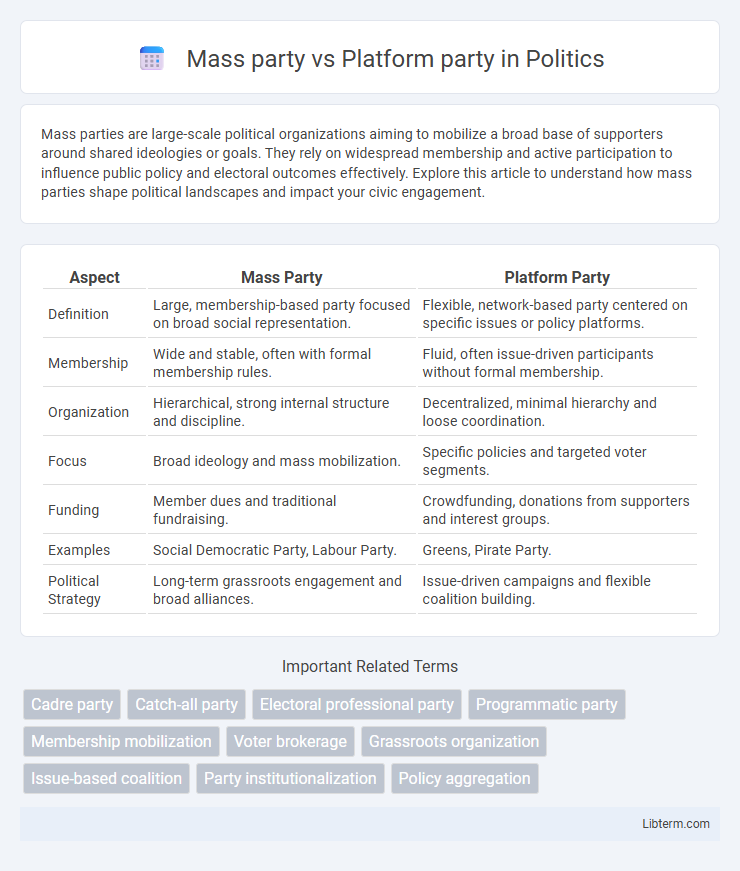Mass parties are large-scale political organizations aiming to mobilize a broad base of supporters around shared ideologies or goals. They rely on widespread membership and active participation to influence public policy and electoral outcomes effectively. Explore this article to understand how mass parties shape political landscapes and impact your civic engagement.
Table of Comparison
| Aspect | Mass Party | Platform Party |
|---|---|---|
| Definition | Large, membership-based party focused on broad social representation. | Flexible, network-based party centered on specific issues or policy platforms. |
| Membership | Wide and stable, often with formal membership rules. | Fluid, often issue-driven participants without formal membership. |
| Organization | Hierarchical, strong internal structure and discipline. | Decentralized, minimal hierarchy and loose coordination. |
| Focus | Broad ideology and mass mobilization. | Specific policies and targeted voter segments. |
| Funding | Member dues and traditional fundraising. | Crowdfunding, donations from supporters and interest groups. |
| Examples | Social Democratic Party, Labour Party. | Greens, Pirate Party. |
| Political Strategy | Long-term grassroots engagement and broad alliances. | Issue-driven campaigns and flexible coalition building. |
Understanding Mass Parties and Platform Parties
Mass parties focus on broad-based membership and grassroots mobilization, aiming to represent large social groups through extensive local organization and recruitment. Platform parties prioritize coherent policy frameworks and ideological consistency, often emphasizing expert-driven decision-making and issue-based campaigns. Understanding these distinctions highlights how mass parties build political power through numbers and participation, while platform parties rely on programmatic clarity and strategic positioning.
Historical Evolution of Political Party Types
Mass parties originated in the late 19th and early 20th centuries, characterized by large memberships and strong grassroots organization aimed at mobilizing working-class voters during periods of industrialization. Platform parties emerged later, prioritizing clear, policy-oriented platforms over broad membership bases, reflecting shifts in political communication and electoral competition in post-industrial societies. This evolution highlights a transition from collective identity politics to issue-centered political strategy driven by media and professionalized politics.
Core Principles of Mass Parties
Mass parties emphasize broad-based membership and active grassroots participation to build a strong, democratic foundation. Their core principles include fostering extensive social mobilization, prioritizing collective interests over elite control, and maintaining close ties to labor unions and social movements. These parties thrive on widespread engagement to influence policy and sustain political legitimacy.
Defining Features of Platform Parties
Platform parties emphasize specialized policy expertise, internal democracy, and professionalized organizational structures that align closely with specific voter segments or ideological goals. They rely on targeted communication strategies and issue-based campaigns to mobilize support, contrasting mass parties that prioritize broad membership bases and social integration. The defining features include a streamlined hierarchy, a clear ideological profile, and adaptability in responding to political and social changes.
Membership Structure: Mass vs Platform Parties
Mass parties traditionally rely on large, active memberships that participate extensively in organizational activities, fostering strong grassroots connections and collective identity. Platform parties emphasize a more streamlined, flexible membership structure often centered around expert networks and policy-driven engagement rather than broad-based mass participation. This shift allows platform parties to adapt quickly to changing political landscapes by prioritizing specialized skills and issue-focused alliances over sheer member numbers.
Organizational Differences and Internal Dynamics
Mass parties emphasize large-scale membership with hierarchical structures designed to mobilize and maintain loyalty among diverse social groups, whereas platform parties prioritize streamlined, issue-focused membership centered on policy expertise and targeted voter engagement. Organizational differences manifest in mass parties' broad grassroots networks and local branches contrasted with platform parties' centralized decision-making and professionalized staff. Internally, mass parties often experience factionalism due to varied member interests, while platform parties maintain cohesion through ideological alignment and strategic messaging.
Electoral Strategies and Voter Mobilization
Mass parties prioritize extensive grassroots organization and broad-based membership to mobilize voters through direct engagement, fostering loyalty and sustained participation. Platform parties concentrate on clear, policy-driven messages and targeted communication, leveraging digital media to attract specific voter segments efficiently. Electoral strategies in mass parties rely on mobilizing large groups via local networks, whereas platform parties focus on strategic messaging to influence voter preferences and optimize election outcomes.
Influence on Policy Development
Mass parties leverage extensive grassroots membership to influence policy development through collective mobilization, ensuring policies reflect broad-based public interests. Platform parties concentrate on specific policy agendas and expert-driven platforms, enabling targeted and coherent policy proposals that gain traction among specialized voter segments. The influence of mass parties is characterized by democratic representation and inclusivity, while platform parties emphasize strategic policy innovation and issue-focused advocacy.
Global Examples of Mass and Platform Parties
Mass parties like Germany's Social Democratic Party (SPD) historically mobilized large memberships around broad labor interests, emphasizing deep organizational structures and face-to-face participation. Platform parties such as Italy's Five Star Movement leverage digital tools and social media platforms to engage supporters, enabling decentralized decision-making and rapid policy feedback loops. Global examples demonstrate mass parties' reliance on traditional grassroots networks, while platform parties exploit technology to reshape political organization and citizen interaction.
Future Trends in Political Party Transformation
Mass parties historically relied on extensive grassroots membership and ideological cohesion, but future trends indicate a shift toward platform parties characterized by flexible policy agendas and digital engagement tools. Emerging political landscapes emphasize data-driven campaign strategies, personalized voter outreach, and coalition-building through online platforms, reducing the importance of traditional mass membership bases. This transformation reflects adaptation to increased political fragmentation, social media influence, and demand for responsive, issue-specific representation.
Mass party Infographic

 libterm.com
libterm.com